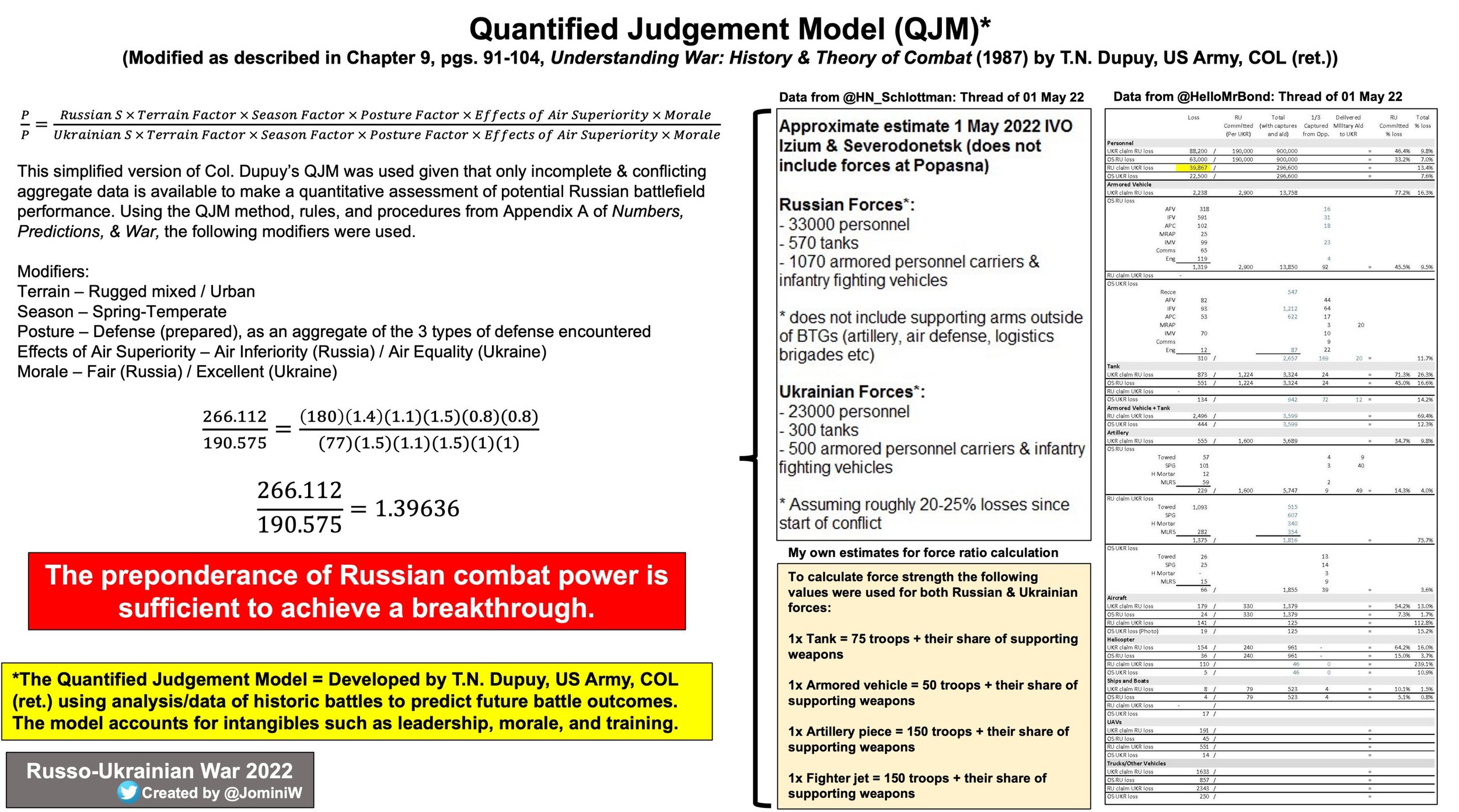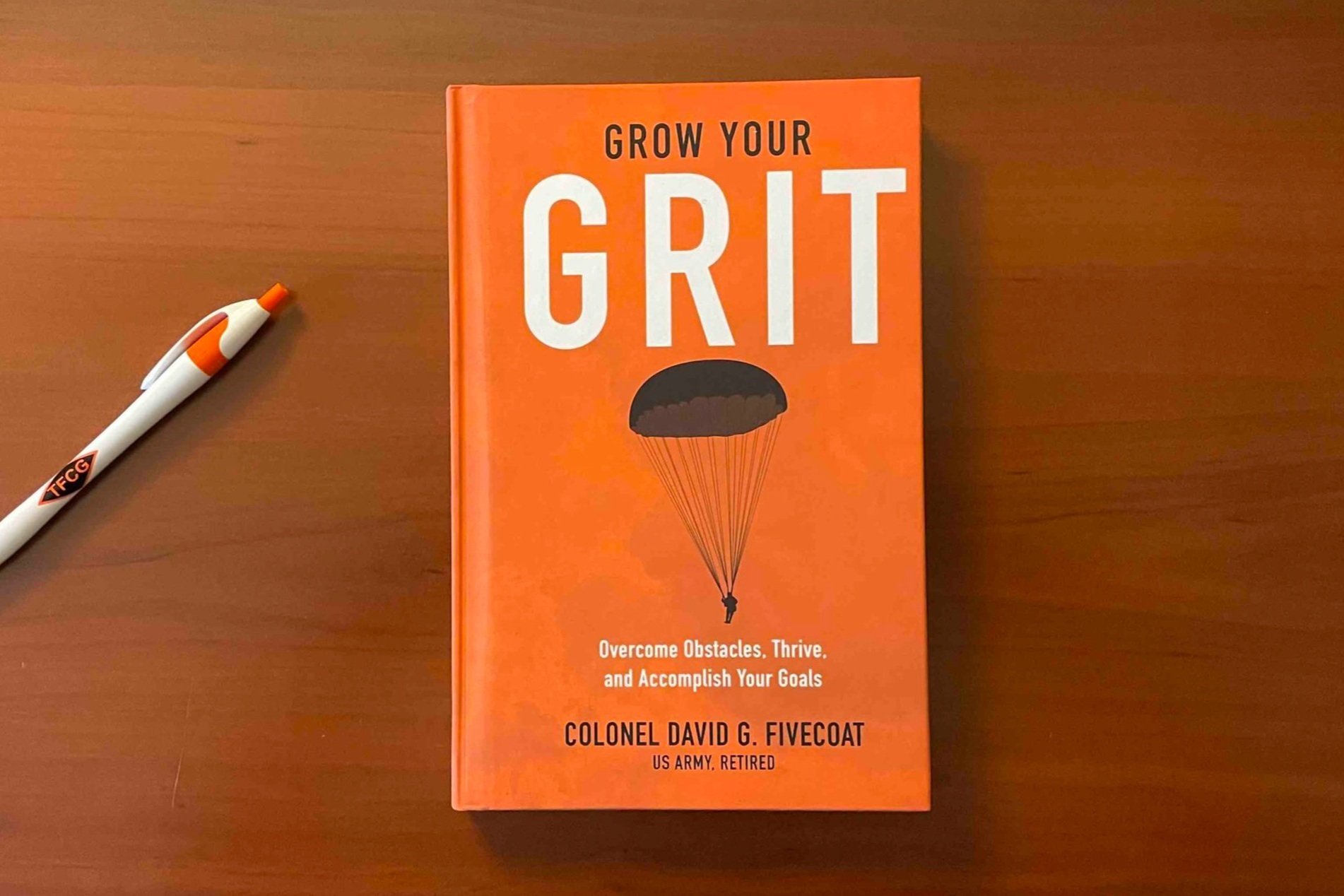Invasion of Ukraine, D+75 SITREP (#213)
Today, May 10, 2022, is D+75 in the Russian Invasion of Ukraine. This blog post discusses modeling of modern conflicts, with a focus on the Correlation of Forces calculator, helps you understand the term “combat power,” and continues the crowd sourced Battle Damage Assessment update of Phase II of the Russian Invasion of Ukraine.
Modeling
The US Army defines combat power as “the total means of destructive, constructive, and information capabilities that a military unit or formation can apply at a given time.” Looking back at the Russian Battalion Tactical Group (see more on the BTG at BTGs, OoB, and Crowd Sourced BDA in Ukraine), the BTG derives its combat power from the combination of tanks (10), BMPs (20), BTRs (10), artillery (6), Multiple Rocket Launchers (6), and air defense weapon systems (6) working together to achieve an objective, like attacking to seize a village or defending a crossroad against an enemy attack. Military forces generate combat power by converting their potential into effective action. To execute combined arms operations (combined arms is the synchronization of tanks, artillery, infantry, and aviation), BTG and other commanders attempt to apply their combat power at a specific point in space and time.
One famous military rule of thumb is the 3:1 rule. The 3:1 rule of combat states that in order that for an attacker to win the battle, his forces should be at least three times the force of the defender. This rule is helpful to understand as this post tries to compare and contrast the current state of combat power in both the Russian and Ukrainian forces.
There is both art and science to modern war. Data is a critical component of forecasting success or failure in modern war. A correlation of forces (COF) calculator is a tool used to help planners compare the relative combat power of two forces and estimate the outcome of engagements between them. Several versions of COF calculators are in use in the Army today. Most use Excel spreadsheets to evaluate the combat power of a tactical or operational operation. Over my two decades in the US Army, I used the COF tool as part of the military planning process to help me and our unit better see the probability of successful mission accomplishment.
COF is a useful modeling tool, but it does have its limitations. First, it doesn’t account for the effects of terrain, weather, or time of day. Second, the Army COF calculators give values for attack aviation (helicopters) but rarely account for fixed wing (US Air Force, US Navy, or US Marine Corps) support. Finally, the COF doesn’t account for the morale of both sides. Despite the limitations, it still is a good tool to give an objective look at a future engagement or an on-going engagement.
I attempted to do a very crude COF analysis for the Russian attack against Ukrainian defenses across Eastern Ukraine using data from April 30, 2022. I gave Ukrainian Brigades the Force Equivalent (FE) value of 4.38. On the Russian side, I gave BTGs based on BMPs the FE value of 1.67 and BTGs based on BTRs a FE value of 1.38. Plugging these numbers into a COF calculator used at the US Army’s Command and General Staff College, I found that Russian forces had a 1.07:1 advantage against Ukrainian defenders. However, this ratio is a far cry from the traditional 3:1 offense:defense ratio used by most planners to guarantee an attack’s success.
Trevor DuPuy’s Qualified Judgement Model and Tactical Numerical Deterministic Model attempt to fix the COF problems by adding factors that account for terrain, air superiority, morale, and offensive or defensive posture. On twitter, many experts are attempting to discern Russian or Ukrainian chances of victory. Jomini of the West (Twitter @JominiW) used Trevor DuPuy’s Qualified Judgement Model with data from May 1, 2022 to evaluate the potential of success of the Russian attack. He concludes the ratio is that Russian attacking forces have a 1.4:1 advantage over Ukrainian defenders. Still a far cry from the 3:1 offense:defense rule of thumb to guarantee an attack’s success.
Both tools confirm what we are seeing on the battlefield — it is increasingly unlikely that Russian forces will achieve victory. On the other hand, Ukrainian forces do not have the combat power to achieve an overwhelming victory either.
A final thought — with access to real-time crowd sourced BDA data and better models than the COF, there is a future business for a company that could do a better job of predicting the outcomes of conflicts in real-time or almost real-time.
Current Situation — Big Picture
Here is Jomini of the West’s (Twitter @JominiW) latest map of the current situation (May 7, 2022). As he states, “The past 6 days has seen Ukrainian forces execute a limited counteroffensive north & northeast of Kharkiv that has produced significant results. Russian forces continue to struggle to gain ground from Izium to Popasna.”
Current Situation — Donetsk Oblast, May 7, 2022
Here is Jomini of the West’s (Twitter @JominiW) map of the current situation in Donetsk (May 7, 2022). As he states, “Russian forces continue to struggle to achieve a general breakthrough along the Siverskyi Donets Line between Izium and Popasna. Along the Izium Axis Russian forces are stalled, unable to gain ground against Ukrainian hasty defensive positions.”
Russian BDA (As of May 9, 2022 at 15:00 EDT the Oryx Website (Only captures losses from April 9 onwards))
Tracking the Russian BDA in Phase II (the battle in eastern Ukraine) is a combination of art and science. From April 9, 2022, I believe that Russian forces have lost in Phase II:
167 Losses (43 ⬆️) out of an estimated 675x T-72/80/90s Tanks — 24.7% Losses (Neutralized)
Average of 5.6x tanks damaged, destroyed, abandoned and captured per day of Phase II
247 Losses (70 ⬆️ )out of an estimated 2,227x BMPs/BTRs/BMDs (Armored Personnel Carriers) — 11.1% Losses (Neutralized)
Average of 8.2x BMPs/BTRs damaged, destroyed, abandoned and captured per day of Phase II
32 Losses (12 ⬆️ ) out of an estimated 282x BAT-2s and 188x IMR-2s (Engineer Vehicles) — 9.5% Losses (Suppressed)
30 Losses (2 ⬆️ ) out of an estimated 405x 152 mm 2S19 Msta and 405x BM-21 122mm MLRS (Field Artillery) — 3.7% Losses (Suppressed)
7 Losses (1 ⬆️ ) out of an estimated 202x Pantsir-S1 (SAMs/ADA) — 3.7% Losses (Suppressed)
63 MT-LB Losses (12 ⬆️) out of an estimated 472x MT-LB ACRV (Command and Control) — 13.3% Losses (Neutralized)
There have not been regular updates or reports on casualties. Until there are updated reports, I will continue to provide this for some perspective:
Yesterday, April 25, 2022 the UK Defense Secretary Ben Wallace stated that “over 15,000 Russian soldiers were killed in Ukraine.”
In addition, there may be another 30,000 Russian soldiers wounded, captured, or missing. Casualties are all soldiers killed, wounded, captured, or missing. With an estimated 190,000 Russian soldiers participating in the invasion — this would represent 23.6% casualties (which, by the way, is in line with the total amount of key ground vehicles lost by the Russian Army).
Revisiting the Battalion Tactical Groups Since February 24, 2022
Still remember the Battalion Tactical Group? It is the building block of the modern Russian Army. US Army soldiers would call a BTG a Task Force. Corporate executives would call a BTG a cross-functional team.
Each Battalion Tactical Group has 10 tanks and 30 BTRs/BMPs as its nucleus. In late 2021, the Russian military announced that it had 170 Battalion Tactical Groups. Here is the organizational chart for the Battalion Tactical Group to refresh your memory.
Since the beginning of the invasion (February 24, 2022), Russian forces have lost 643 Tanks and 923 BTRs/BMPs (infantry vehicles). Taking it a step further — 60 Battalion Tactical Groups (35% of ALL Russian BTGs (not just the 100+ that participated in the invasion) have had ALL of their tanks destroyed, captured, or abandoned since the beginning of the war. Russia only produces 200 tanks in one year! 30 Battalion Tactical Groups (17.6% of ALL Russian BTGs) have had ALL of their BTRs or BMPs destroyed, captured, or abandoned. Russia losing tanks and BTRs/BMPs at its current rate (6 tanks and 8 BMPs/BTRs a day) is unsustainable.
Ukrainian BDA (As of May 9, 2022 at 1500 EDT the Oryx Website)
I did not reset the Ukrainian data. However, it is a good start point. So far, according to Oryx, Ukrainian forces have lost:
155 Losses (10 ⬆️ ) out of an estimated 630x T-64/80s Tanks — 24.6% Losses (Neutralized)
232 Losses (11 ⬆️) out of an estimated 2,215x BMPs/BTRs/BMDs (Armored Personnel Carriers) — 10.4% Losses (Neutralized)
71 Losses (2 ⬆️) out of an estimated 306x 152 mm 2S19 Msta and 306x BM-21 122mm MLRS (Field Artillery) — 11.6% Losses (Neutralized)
15 MT-LB Losses (No Change) out of an estimated 476x MT-LB ACRV (Command and Control) — 3.1% Losses (Suppressed)
Once again, there have not been regular updates or reports on casualties. Until there are updated reports, I will continue to provide this for some perspective:
President Zelenskyy said during an April 15, 2022 interview with CNN that over 2,750 Ukrainian soldiers had been killed (US estimates were 3,000) and over 10,000 wounded. This number does not include civilian casualties.
More Information on the Conflict:
Leading During the Crisis in Ukraine and D+67 SITREP
Invasion of Ukraine, D+60, SITREP
Invasion of Ukraine, D+53, SITREP
Invasion of Ukraine, D+47, SITREP
BTGs, OoB, and Crowd Sourced BDA in Ukraine, D+11
Conclusion
Want even more? Reach out to me me here for a virtual talk to your group or company on the Invasion of Ukraine and its tactical and strategic implications. Just did a great talk with some banking executives from the midwest.
Want something different? In my day job, I’m an executive coach and leadership consultant. I published a book last summer on how to develop your perseverance and accomplish your goals — Grow Your Grit, available for sale at Amazon. Or reach out to me here to start the discussion about executive coaching opportunities.
Use your deeper awareness of the invasion of Ukraine to go on the offensive and follow the conflict with better insight.






